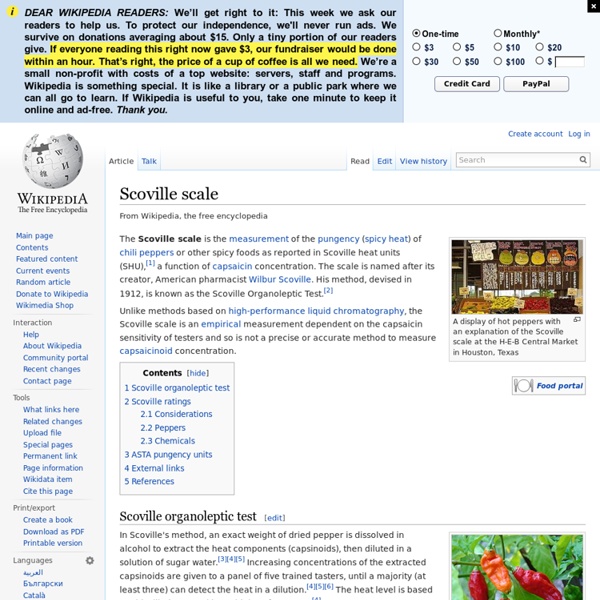Scoville scale
A display of hot peppers with an explanation of the Scoville scale at the H-E-B Central Market in Houston, Texas The Scoville scale is the measurement of the pungency (spicy heat) of chili peppers or other spicy foods as reported in Scoville heat units (SHU),[1] a function of capsaicin concentration. The scale is named after its creator, American pharmacist Wilbur Scoville. Unlike methods based on high-performance liquid chromatography, the Scoville scale is an empirical measurement dependent on the capsaicin sensitivity of testers and so is not a precise or accurate method to measure capsaicinoid concentration. Scoville organoleptic test[edit] Scoville ratings[edit] Considerations[edit] Since Scoville ratings are defined per unit of dry mass, comparison of ratings between products having different water content can be misleading. ASTA pungency units[edit] External links[edit] References[edit]
Freelance Writing Jobs!
No Deadlines: Write Whenever you Want As a wiseGEEK writer, you'll be able to login to our system whenever you want; set your own hours and work whenever it fits into your schedule. Write from Anywhere wiseGEEK writers can work from anywhere they have an internet connection. You'll be able to work at a cafe, in the yard, at a library, or from your kitchen table. Choose your Topics Our writers get to choose their favorite topics from an open pool of at least 500 topics. Work Directly with your Own Editor Each wiseGEEK writer is assigned to a dedicated, experienced and receptive editor. Educate Millions of People wiseGEEK is read by over 15.5 Million people each month (well over 100 million visitors per year). Get Paid Quickly Some jobs only pay once or twice a month. Focus on Writing: We Handle the Rest In many other online writing jobs, writers are required to promote their own submissions. Straightforward Answers wiseGEEK Monthly Visitors Dedicated Team Quality Content Comprehensive Broad Reach No.
wiseGEEK dot com (wiseGEEK)
wiseGEEK: clear answers for common questions
Conjecture Corporation
Related:
Related:



